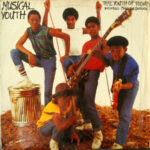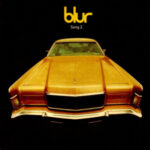#12: Metallica – Enter Sandman
The guitar riff in Metallica’s “Enter Sandman” is one of the most recognizable and iconic in the history of heavy metal and rock music. Composed by James Hetfield and Kirk Hammett, this opening riff sets the tone for the entire song and is a hallmark of Metallica’s signature sound.
The riff is deceptively simple yet incredibly powerful. It’s played with palm-muted downstrokes on the low E string, creating a chugging, menacing quality that immediately grabs the listener’s attention. The repetitive, hypnotic nature of the riff adds to the song’s intensity and headbanging appeal.
What makes this riff so memorable is its ability to establish a mood of foreboding and anticipation. As it segues into the rest of the song, it perfectly complements the dark lyrical themes of nightmares and fear. Moreover, the way it seamlessly transitions into the main riff of the song is a testament to Metallica’s songwriting and riff-crafting prowess.
“Enter Sandman” is not just a classic heavy metal song; it’s a testament to the power of a well-crafted guitar riff to define an entire track and become a timeless symbol of a band’s musical legacy.
#11: Steppenwolf – Born To Be Wild
The guitar riff in Steppenwolf’s “Born to Be Wild” is a legendary, pioneering force in rock music. Released in 1968, this iconic riff, written by guitarist Mars Bonfire, is a watershed moment in the history of rock ‘n’ roll. It’s a relatively simple but electrifying sequence of notes, often considered one of the first instances of heavy metal and hard rock. The riff is defined by its gritty, rebellious spirit, setting the tone for the entire song and its celebration of the open road and counterculture freedom.
What makes this riff enduring is its raw, infectious energy. It’s a call to rebellion, a soundtrack for those seeking adventure and defying conventions. “Born to Be Wild” and its quintessential riff have left an indelible mark on the rock music landscape, becoming an anthem for the free-spirited and an enduring symbol of the golden era of rock ‘n’ roll.
#10: Rolling Stones – Satisfaction
The guitar riff in The Rolling Stones’ “(I Can’t Get No) Satisfaction” is one of the most iconic and instantly recognizable in rock music history. Created by Keith Richards, this riff is legendary for its simplicity, yet its impact is immeasurable. It features a series of fuzzed-out power chords played on the electric guitar, providing a gritty and aggressive quality that perfectly encapsulates the song’s rebellious spirit.
Richards came up with the riff in his sleep and recorded it on a cassette player beside his bed. The riff is marked by its irresistible hook, which opens the song and instantly grabs the listener’s attention. The repetitive, driving nature of the riff, combined with Mick Jagger’s frustrated lyrics, conveys the essence of youthful angst and desire.
“(I Can’t Get No) Satisfaction” is not just a classic rock song; it’s a symbol of the 1960s counterculture and an enduring hallmark of The Rolling Stones’ influence on the evolution of rock music. It remains a timeless representation of rebellion and desire in the world of rock and roll.
#9: Ozzy Osbourne – Crazy Train
The guitar riff in Ozzy Osbourne’s “Crazy Train” is an absolute powerhouse of rock and metal music. Composed by the legendary Randy Rhoads, the riff is characterized by its intricate, lightning-fast picking and a blend of heavy metal power and classical-influenced melodic elements.
Rhoads’ riff in “Crazy Train” opens the song with a distinct, high-energy, and instantly recognizable pattern. It’s a testament to his virtuosity as a guitarist, combining palm-muted chugging with precise melodic runs, showcasing the full range of his technical abilities.
This riff captures the song’s chaotic, frenetic atmosphere, aligning perfectly with the theme of mental instability and turmoil. Rhoads’ innovative approach to guitar playing and his melding of classical techniques into heavy metal have made “Crazy Train” a landmark song in the genre.
Decades after its release, this riff remains a favorite among guitarists and a highlight of Ozzy Osbourne’s live performances. It is an enduring symbol of Rhoads’ impact on rock and metal music, continuing to inspire countless guitarists and fans of the genre.
#8: The Police – Every Breath You Take
The guitar riff in The Police’s “Every Breath You Take” is a deceptively simple yet profoundly effective musical element. Composed by the band’s frontman and guitarist, Sting, the riff consists of a repeating, gentle arpeggio pattern played on an electric guitar. What makes this riff so iconic is its haunting and hypnotic quality, which perfectly complements the song’s lyrical themes of obsession and possessiveness.
Sting’s minimalist approach allows for the emotional weight of the song to take center stage. The riff, along with the song’s signature bassline, creates a sense of quiet, unrelenting tension, symbolizing the dark undercurrents of love and surveillance.
“Every Breath You Take” is celebrated as a classic and one of The Police’s most recognizable songs, in large part due to the simple yet evocative guitar riff. The riff’s gentle yet ominous tone underscores the song’s lasting impact and enduring popularity, making it a beloved part of the musical landscape for over three decades.
#7: Van Halen – Ain’t Talkin’ ‘Bout Love
The guitar riff in Van Halen’s “Ain’t Talkin’ ‘Bout Love” is an electrifying and unforgettable rock riff, emblematic of Eddie Van Halen’s groundbreaking guitar virtuosity. Released on their self-titled debut album in 1978, this riff is a defining moment in rock music history.
The riff is characterized by its high-energy, driving, and relentless power chords. It’s a prime example of Eddie Van Halen’s innovative guitar technique and the pioneering “tapping” style he popularized. The riff’s immediacy and aggressiveness are central to the song’s infectious appeal.
Eddie Van Halen’s distinctive style and virtuosity shine in “Ain’t Talkin’ ‘Bout Love.” His use of harmonics, palm muting, and rapid finger-tapping techniques contributed to a new level of excitement and technical skill in rock guitar playing.
This iconic riff is celebrated as one of the defining moments in the world of rock guitar, influencing countless guitarists and rock bands. “Ain’t Talkin’ ‘Bout Love” remains a timeless classic and an enduring symbol of Eddie Van Halen’s monumental impact on rock music.
#6: ZZ Top – La Grange
The guitar riff in ZZ Top’s “La Grange” is a blues-rock masterpiece, an essential component of the band’s signature sound. Released in 1973 on their album “Tres Hombres,” the riff is the backbone of the song and is instantly recognizable.
The riff, created by Billy Gibbons, is a gritty, infectious sequence of slide guitar and electric blues licks. It’s a prime example of the Texas blues-rock style that ZZ Top is known for, characterized by its raw energy and groove.
What makes this riff so iconic is its unpretentious, back-to-basics bluesiness. It captures the essence of the roadhouse blues and rock ‘n’ roll spirit that ZZ Top personifies. The riff’s simplicity belies its infectiousness, and its raw, unpolished quality adds to the song’s appeal.
“La Grange” is celebrated as one of ZZ Top’s greatest hits and a defining song in the blues-rock genre. The riff’s enduring popularity is a testament to its timeless quality and its place in rock history as a classic representation of the Texas blues-rock sound.
#5: ACDC – Highway to Hell
The guitar riff in AC/DC’s “Highway to Hell” is one of the most iconic and instantly recognizable riffs in rock music history. Composed by brothers Angus and Malcolm Young, this riff is the driving force behind the song’s undeniable energy and appeal.
The riff is characterized by its infectious, straightforward, and blues-inspired pattern played on Angus Young’s Gibson SG guitar. It sets the tone for the entire track, with its head-bobbing groove and raucous rock ‘n’ roll spirit. The repetition of the riff throughout the song provides a sense of unrelenting momentum and excitement.
What makes this riff legendary is its simplicity, yet it encapsulates the essence of AC/DC’s hard-hitting and electrifying sound. It’s a prime example of the band’s signature style, combining rock, blues, and a touch of punk attitude.
“Highway to Hell” remains a classic and one of AC/DC’s most beloved songs. The riff’s enduring popularity is a testament to its timeless rock ‘n’ roll quality, making it a staple in the band’s live performances and a must-listen for any rock enthusiast.
#4: Guns N’ Roses – Sweet Child O’ Mine
The guitar riff in Guns N’ Roses’ “Sweet Child O’ Mine” is a timeless masterpiece of rock music. Composed by the band’s lead guitarist, Slash, this riff is celebrated for its combination of melody, technical prowess, and emotional depth.
The riff opens the song with a sense of anticipation and sweet melancholy. It’s characterized by its soaring, ascending melody, played on the high strings of the guitar, making it instantly recognizable. Slash’s use of string bending and precise articulation adds to the riff’s emotive quality.
What sets this riff apart is its ability to convey both longing and optimism. It’s both a declaration of love and an expression of yearning. The riff serves as a powerful prelude to Axl Rose’s evocative vocals, making “Sweet Child O’ Mine” an enduring rock ballad.
This iconic riff is celebrated as one of the greatest in rock history, influencing countless guitarists and captivating audiences for decades. It remains a cherished staple of Guns N’ Roses’ live performances and a testament to the band’s enduring impact on the world of rock music.
#3: Lynyrd Skynyrd – Sweet Home Alabama
The guitar riff in Lynyrd Skynyrd’s “Sweet Home Alabama” is an emblematic piece of Southern rock history. Composed by Ed King, this iconic riff is celebrated for its catchiness, simplicity, and unmistakable Southern charm.
The riff opens the song with a sense of invitation and warmth. It’s characterized by its sliding double-stop pattern, providing a sense of laid-back groove and an unmistakable “Southern” sound. The riff’s simplicity is a testament to its enduring appeal, making it one of the most recognizable and beloved in rock music.
What sets this riff apart is its ability to instantly transport listeners to the South, as it evokes images of a sunny day, open roads, and a carefree spirit. It captures the essence of Southern culture and Lynyrd Skynyrd’s love for their home state, Alabama.
“Sweet Home Alabama” is celebrated as one of the greatest anthems of the South and a classic rock song. The riff’s timeless quality is a testament to its place in the pantheon of rock music, making it a cherished part of Lynyrd Skynyrd’s live performances and an enduring symbol of Southern rock.
#2: Derek and The Dominos – Layla
The guitar riff in Derek and The Dominos’ “Layla” is one of the most famous and distinctive riffs in rock history. Composed by Eric Clapton and Duane Allman, this riff is celebrated for its emotional depth, complexity, and the soulful interplay between the two guitarists.
The riff is introduced at the beginning of the song, setting the tone for the entire composition. It’s characterized by its bluesy, melancholic, and instantly captivating melody, played in a fingerstyle manner. The juxtaposition of Clapton’s and Allman’s guitars creates a powerful musical conversation, allowing each instrument to shine and complement the other.
What sets this riff apart is its ability to convey a sense of yearning and passion, mirroring the lyrical theme of unrequited love. The riff’s emotional intensity is a hallmark of “Layla” and contributes to the song’s timeless appeal.
“Layla” is celebrated as a classic in rock music history, and the riff is a testament to the brilliance of both Clapton and Allman as guitarists. It remains a cherished part of Clapton’s live performances and is an enduring symbol of the virtuosity and emotional depth that great guitar playing can convey.
#1: Deep Purple – Smoke On The Water
The guitar riff in Deep Purple’s “Smoke on the Water” is one of the most iconic and instantly recognizable riffs in the history of rock music. Composed by Ritchie Blackmore, this riff is celebrated for its simplicity, yet it’s a testament to the power of a memorable, hard-rocking melody.
The riff opens the song and serves as its foundation. It’s characterized by a descending pattern of power chords played with a crunchy, distorted tone, which creates a distinctive and heavy sound. The rhythmic drive and catchy, repetitive nature of the riff make it a classic and unforgettable rock moment.
What sets this riff apart is its historical significance. “Smoke on the Water” tells the true story of a fire that broke out during a Frank Zappa concert in Montreux, Switzerland, and the riff captures the chaos and intensity of that event. It’s a simple yet effective expression of rock music’s power and storytelling ability.
The riff is celebrated as one of the greatest in rock history, and “Smoke on the Water” remains a rock classic, cherished by generations of music enthusiasts. It’s a symbol of the enduring appeal of Deep Purple and their influence on the rock genre.
This post has already been read 226 times!









